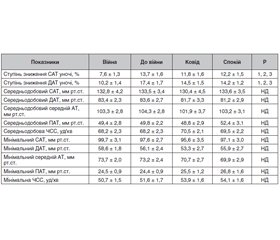Журнал «» Том 16, №1-2, 2023
Вернуться к номеру
Особливості перебігу артеріальної гіпертензії у пацієнтів під час широкомасштабного вторгнення в Україні
Авторы: Торбас О.О., Прогонов С.О.
ДУ «ННЦ «Інститут кардіології, клінічної та регенеративної медицини імені академіка М.Д. Стражеска»
НАМН України», м. Київ, Україна
Рубрики: Кардиология
Разделы: Клинические исследования
Версия для печати
Мета: оцінити вплив різних зовнішніх чинників та стресу внаслідок широкомасштабного військового вторгнення на добовий профіль артеріального тиску (АТ). Матеріали та методи. Це ретроспективний аналіз обстежених пацієнтів, яким було проведено ДМАТ за останні 5 років. Ми розділили умовно період спостереження на декілька часових інтервалів: група «Війна», група «До війни», група «Ковід», група «Спокій», у які методом випадкових чисел було відібрано по 20 пацієнтів. Усім пацієнтам було проведено ДМАТ за допомогою приладу Watch BP 03 (Microlife AG, Швейцарія). Було сформовано базу даних та проведено статистичний аналіз результатів за допомогою програмного пакета IBM SPSS 26.0. Результати. Усі групи були порівнянними за віком, гендерним складом та середньодобовими параметрами АТ і ЧСС. Пацієнти були середнього віку, чоловіків і жінок у всіх групах було порівну, порівнянні за результатами середньодобових САТ, ДАТ, ПАТ і ЧСС. Ми виявили, що у групі «Війна» був достовірно нижчий відсоток зниження САТ і ДАТ уночі порівняно із усіма іншими групами (7,6 ± 1,3 % для САТ і 10,2 ± 1,4 % для ДАТ). Стандартне відхилення САТ і ДАТ було достовірно вищим у групі «До війни» (19,8 ± 1,1 та 14,2 ± 0,7 відповідно) порівняно із групами «Війна» (16,0 ± 0,9 та 11,7 ± 0,6 відповідно) та «Ковід» (16,2 ± 0,7 та 11,8 ± 0,7 відповідно). Найбільша частота нон-диперів для САТ і ДАТ спостерігалася у групі «Війна» (60 і 45 % відповідно). Висновки. Під час війни у пацієнтів із АГ зниження САТ і ДАТ вночі виявилося достовірно нижчим, ніж у групах «До війни», «Ковід», «Спокій». Також у цій групі відмічалася більша кількість нон-диперів.
Background. The purpose was to assess the influence of various external factors and stress due to a large-scale military invasion on the daily blood pressure profile. Materials and methods. This was a retrospective analysis of examined patients who underwent ambulatory blood pressure monitoring in the last 5 years. We conditionally divided the observation period into several time intervals: “War”, “Before the war”, “Covid”, and “Peace” groups, 20 patients in each who were selected by the method of random numbers. All patients underwent ambulatory blood pressure monitoring using the WatchBP O3 device (Microlife AG, Switzerland). The database was formed, and statistical analysis of the results was carried out using the IBM SPSS 26.0 software package. Results. All groups were comparable in terms of the age, gender, average daily blood pressure and heart rate parameters of participants. Patients were middle-aged, the number of men and women was equal in all groups, groups were comparable according to the results of average daily systolic (SBP), diastolic blood pressure (DBP), pulse pressure and heart rate. We found that “War” group had a significantly lower percentage of SBP and DBP decrease at night compared to other groups (7.6 ± 1.3 % for SBP and 10.2 ± 1.4 % for DBP). The standard deviation of SBP and DBP was significantly higher in “Before the war” group (19.8 ± 1.1 and 14.2 ± 0.7, respectively) compared to “War” (16.0 ± 0.9 and 11.7 ± 0.6, respectively) and “Covid” groups (16.2 ± 0.7 and 11.8 ± 0.7, respectively). The highest frequency of non-dippers for SBP and DBP was observed in “War” group (60 and 45 %, respectively). Conclusions. During the war, the reduction of SBP and DBP at night in hypertensive patients was significantly lower than in “Before the war”, “Covid”, and “Peace” groups. There was also a higher number of non-dippers in this group.
стрес; артеріальна гіпертензія; добове моніторування артеріального тиску
stress; hypertension; daily blood pressure monitoring

